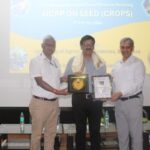
Communication major dimensions scheme
Communication code scheme
Communication is usually described along a few major dimensions: Content (what type of things are communicated), source, emisor, sender or encoder (by whom), form (in which form), channel (through which medium), destination, receiver, target or decoder (to whom), and the purpose or pragmatic aspect. Between parties, communication includes acts that confer knowledge and experiences, give advice and commands, and ask questions. These acts may take many forms, in one of the various manners of communication. The form depends on the abilities of the group communicating. Together, communication content and form make messages that are sent towards a destination. The target can be oneself, another person or being, another entity (such as a corporation or group of beings).
Communication can be seen as processes of information transmission governed by three levels of semiotic rules:
- Syntactic (formal properties of signs and symbols),
- Pragmatic (concerned with the relations between signs/expressions and their users) and
- Semantic (study of relationships between signs and symbols and what they represent).
Therefore, communication is social interaction where at least two interacting agents share a common set of signs and a common set of semiotic rules. This commonly held rules in some sense ignores auto communication, including intrapersonal communication via diariesor self-talk, both secondary phenomena that followed the primary acquisition of communicative competences within social interactions.
Every communication situation involves certain elements.
Communication models are visualization of the communication process. There are different models seeking to explain the process of communication. These models differ with each other. None can be said to be completely right or perfect. Some may be more useful than others. Some of the models are:
1)Aristotle, who gave a model of communication that includes three steps:
| Speaker—— Speech—–Audience |
He emphasized the audience and suggested that the speech should be at the level of the audience.
| Who say?, What?, Through which channel?, To whom?, With what effect? |
2. Harold Hosswell, a political scientist has given a paradigm to communication in which he has summarized the whole field of communication in a nutshell to understand the following steps of communication.
‘who’ is related with communicator, ‘what’ is related with message or subject matter, the ‘channel’ indicates media, ‘to whom’ indicates the receiver and with what effect denotes change in behavior due to communication.
3. Shannon and Warren Weaver, presented a model of communication in mathematical formula to measure information flow and both of them emphasized that noise distracts the flow of information. They said that the ingredients in communication include:
| Source—Transmitter—Signal—Receiver—Destination |
4) Schramm gave a model – when he was working on mass communication and its effects on audience. He emphasized the senders and recivers experiences. His field model looked as follows.
| Source—Encoder—Signal—Decoder—Destination |
His emphasis was on how communication works Sender’s field of experience
Here he introduced encode and decode as an important items in communication.
5)Berlo’s model – emphasized on persuasion that through communication we can persuade people as follows.
| Source—Encoder—Message—Channel—Decoder—Receiver |
Encoding deficiency, gatekeepers, and interference are terms used with the S-M-C-R Model to describe some basic problem areas that are inherent in communications.
- Encoding deficiency relates mostly to the sender’s lack of communication skills and knowledge of the audience. This might involve using words or examples the receivers do not understand. A sender might refer to apiculture when beekeeping would have been understood. He or she might speak with a nasty, scolding tone that confuses the audience.
- Gatekeepers are people that control the media or other access to communication channels. For instance, an extension worker might have an important message about a livestock disease that threatens his district, but a warning message can only be broadcast on the radio if the radio station programmer allows it. Similarly, newspaper editors control what’s published in their newspaper.
- Interference is often a more physical problem to reaching a target audience. If an extension agent is allowed to voice an announcement over a local radio station, the receiver may not receive the message because of radio interference, or a baby crying so loudly that the farmer can’t hear the message.
6)Westty and Machean Model – This model has five elements
Here the sender encodes the message which is passed through a channel and then decoded. Its meaning is drawn out after which the message is clear to the receiver.
| Source—Encoder—Channel—Decoder—Receiver |
7.Leagan’s Model – Leagan says that for a complete communication process six elements are essential. These are as follows:
| Communicater—Message—Channel—Treatment—Receiver—Response |
8.Rogers and Shoemaker(1971). It is also called the SMCR model. It is an oversimplified, but useful model. It consists of:
| Sourse—Message—Channel—Receiver—Effect |
An additional element, the ‘effects’ of communication could be added. The effects are changes in knowledge, attitude and oven behavior, as a result of technology.
| Noise |
9.Litterers Model
| Selection—Encoding—Transmission | Detection—Decoding— Selection | ||||
| Channel |
10.Dance’s Helical Model – The earliest model of communication were linear, their successors were circular, emphasizing the crucial factor of feedback in the communication process.

Frank E.X.Dance in ‘A helical model of communication; (1967) commends the circular model as an advance upon the linear one but faults in on the grounds that it suggests that communication comes back full, circle, to exactly the same point from which it started, an assumption which is manifestly erroneous’. The helix or spiral model combines the desirable of the straight line and of the circle while avoiding the weakness of either.







Leave a Reply